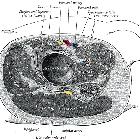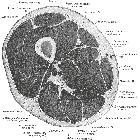Musculus sartorius




The sartorius muscle is the long obliquely oriented muscle of the anterior compartment of the thigh. It is the longest muscle in the human body.
Summary
- origin: immediately below the anterior superior iliac spine
- insertion: as part of the pes anserinus tendon (upper end of the subcutaneous surface of the tibia)
- action
- primary: flexion of the hip and knee
- secondary: lateral rotation and weak abduction of the thigh (such as when sitting cross-legged)
- innervation: individual muscular branch from anterior division of the femoral nerve (L2, L3, L4)
- blood supply: muscular branch from the common femoral artery
Gross anatomy
The sartorius muscle has long parallel fibers that extend for the whole length of the muscle, running obliquely from lateral to medial down the thigh anterior to the quadriceps, in the same direction as the inguinal ligament and the fibers of the external oblique muscles. It spirals obliquely down across the thigh, passes downwards on the fascial roof of the adductor canal, lies near the posterior aspect of the medial condyle of the femur whence its tendon proceeds to insert onto the upper end of the tibia.
The medial border of the sartorius is the lateral boundary of the femoral triangle. It forms the anterior boundary of the adductor canal.
Relations:
Deep
- fascial roof of adductor canal, containing
- superficial femoral vessels
- saphenous nerve
- nerve to the vastus medialis muscle
Near origin
- pierced by the intermediate cutaneous nerve of thigh
Near insertion
- posterior
- gracilis and semitendinosus tendons
- deep
- bursae separating it from the gracilis and semitendinosus tendons
- pierced by the infrapatellar branch of saphenous nerve above the insertion of the sartorius
Action
To draw the lower limb into the sitting tailor's position (hip flexed and laterally rotated, knee flexed). Flexion, abduction and lateral rotation of the hip. Flexion of the knee.
Variants
May originate from the outer end of the inguinal ligament, the iliac notch, the iliopectineal line or the pubis.
The muscle may split into two parts, one of which may be inserted onto the fascia lata, the femur, the patellar ligament, or the tendon of semitendinosus.
History and etymology
Named after tailors (sartor is Latin for tailor), who would often sit cross-legged when working.
Siehe auch:
und weiter:

 Assoziationen und Differentialdiagnosen zu Musculus sartorius:
Assoziationen und Differentialdiagnosen zu Musculus sartorius:

